A Report on Qualitative Research: HPV, Trustworthiness, and Rigor
VerifiedAdded on 2023/01/19
|8
|2545
|100
Report
AI Summary
This report examines a qualitative research study on Human Papillomavirus (HPV), focusing on trustworthiness, rigor, sampling methods, data collection, and data analysis. The report is divided into four parts, covering the importance of trustworthiness and rigor in qualitative research, the sampling process involving 20 Korean females aged 18-26, the data collection methods using focus group interviews, and the data analysis using open coding integrated with NEM and TPB. The study emphasizes the validity and reliability of the research, highlighting the importance of transparency, credibility, and usefulness in ensuring meaningful and accurate results. The report also discusses the ethical considerations, the use of multiple researchers, and the methods used to ensure the accuracy and authenticity of the findings. The study provides valuable insights into the impact of HPV and the importance of qualitative research in public health.

Report
Paraphrase This Document
Need a fresh take? Get an instant paraphrase of this document with our AI Paraphraser
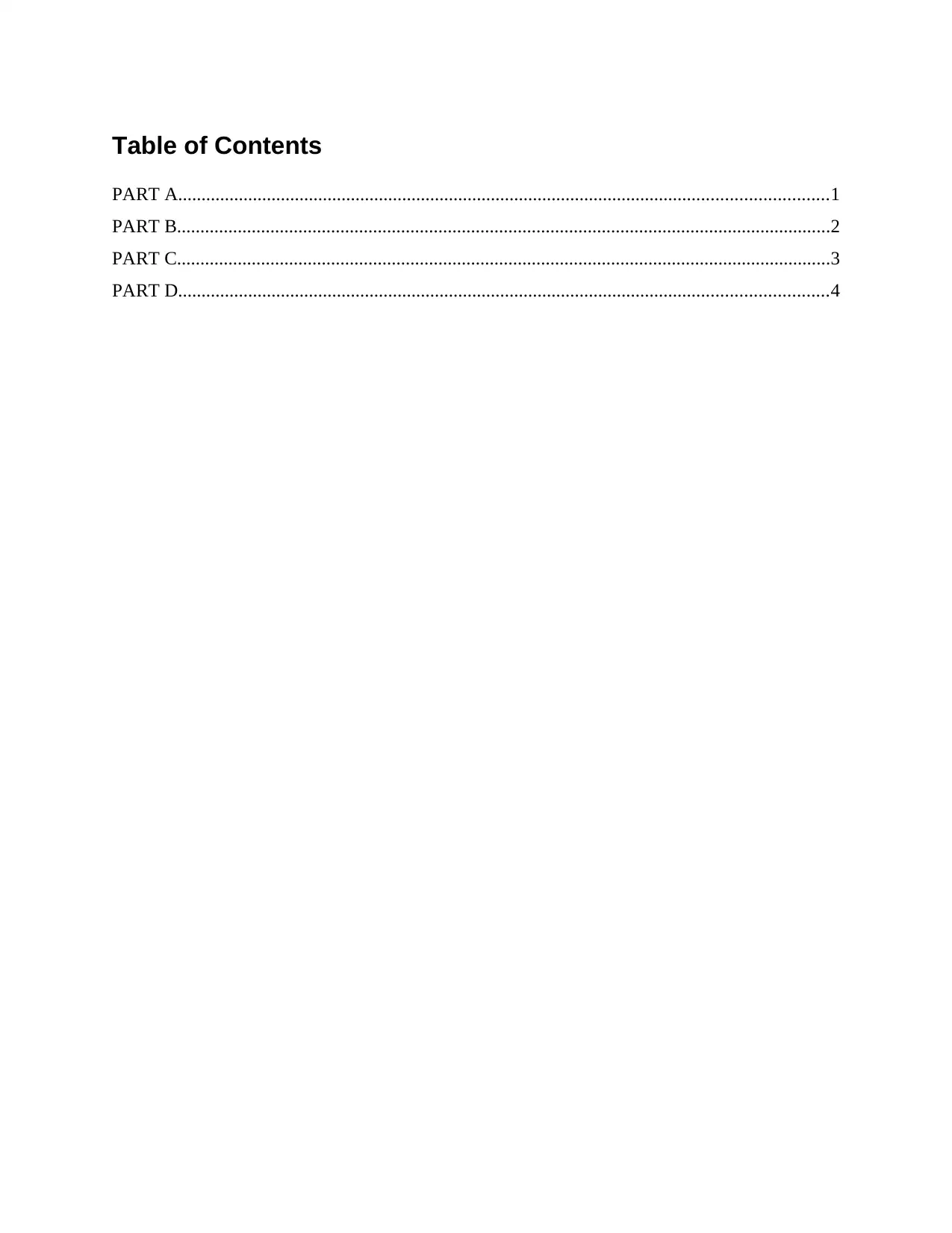
Table of Contents
PART A...........................................................................................................................................1
PART B............................................................................................................................................2
PART C............................................................................................................................................3
PART D...........................................................................................................................................4
PART A...........................................................................................................................................1
PART B............................................................................................................................................2
PART C............................................................................................................................................3
PART D...........................................................................................................................................4
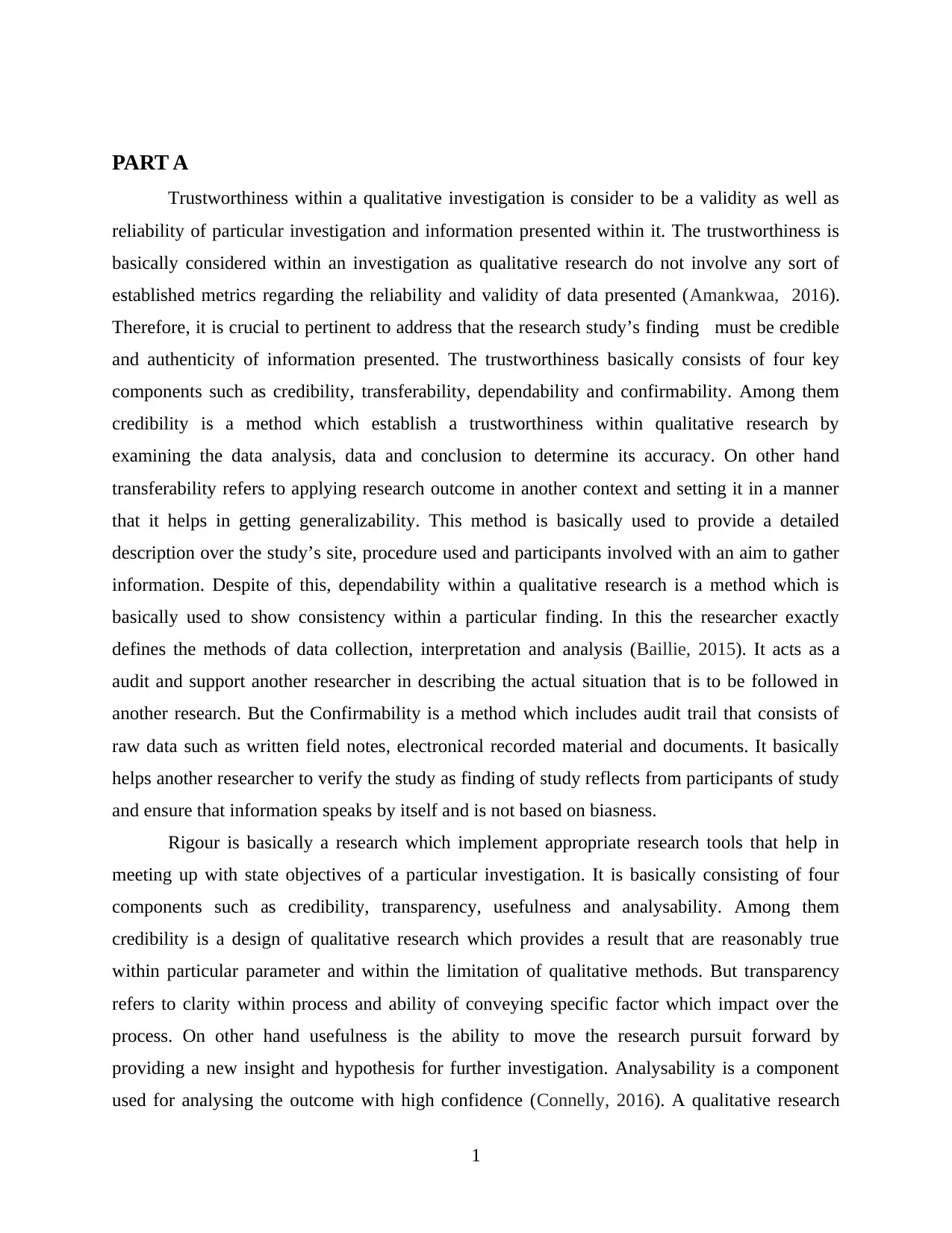
PART A
Trustworthiness within a qualitative investigation is consider to be a validity as well as
reliability of particular investigation and information presented within it. The trustworthiness is
basically considered within an investigation as qualitative research do not involve any sort of
established metrics regarding the reliability and validity of data presented (Amankwaa, 2016).
Therefore, it is crucial to pertinent to address that the research study’s finding must be credible
and authenticity of information presented. The trustworthiness basically consists of four key
components such as credibility, transferability, dependability and confirmability. Among them
credibility is a method which establish a trustworthiness within qualitative research by
examining the data analysis, data and conclusion to determine its accuracy. On other hand
transferability refers to applying research outcome in another context and setting it in a manner
that it helps in getting generalizability. This method is basically used to provide a detailed
description over the study’s site, procedure used and participants involved with an aim to gather
information. Despite of this, dependability within a qualitative research is a method which is
basically used to show consistency within a particular finding. In this the researcher exactly
defines the methods of data collection, interpretation and analysis (Baillie, 2015). It acts as a
audit and support another researcher in describing the actual situation that is to be followed in
another research. But the Confirmability is a method which includes audit trail that consists of
raw data such as written field notes, electronical recorded material and documents. It basically
helps another researcher to verify the study as finding of study reflects from participants of study
and ensure that information speaks by itself and is not based on biasness.
Rigour is basically a research which implement appropriate research tools that help in
meeting up with state objectives of a particular investigation. It is basically consisting of four
components such as credibility, transparency, usefulness and analysability. Among them
credibility is a design of qualitative research which provides a result that are reasonably true
within particular parameter and within the limitation of qualitative methods. But transparency
refers to clarity within process and ability of conveying specific factor which impact over the
process. On other hand usefulness is the ability to move the research pursuit forward by
providing a new insight and hypothesis for further investigation. Analysability is a component
used for analysing the outcome with high confidence (Connelly, 2016). A qualitative research
1
Trustworthiness within a qualitative investigation is consider to be a validity as well as
reliability of particular investigation and information presented within it. The trustworthiness is
basically considered within an investigation as qualitative research do not involve any sort of
established metrics regarding the reliability and validity of data presented (Amankwaa, 2016).
Therefore, it is crucial to pertinent to address that the research study’s finding must be credible
and authenticity of information presented. The trustworthiness basically consists of four key
components such as credibility, transferability, dependability and confirmability. Among them
credibility is a method which establish a trustworthiness within qualitative research by
examining the data analysis, data and conclusion to determine its accuracy. On other hand
transferability refers to applying research outcome in another context and setting it in a manner
that it helps in getting generalizability. This method is basically used to provide a detailed
description over the study’s site, procedure used and participants involved with an aim to gather
information. Despite of this, dependability within a qualitative research is a method which is
basically used to show consistency within a particular finding. In this the researcher exactly
defines the methods of data collection, interpretation and analysis (Baillie, 2015). It acts as a
audit and support another researcher in describing the actual situation that is to be followed in
another research. But the Confirmability is a method which includes audit trail that consists of
raw data such as written field notes, electronical recorded material and documents. It basically
helps another researcher to verify the study as finding of study reflects from participants of study
and ensure that information speaks by itself and is not based on biasness.
Rigour is basically a research which implement appropriate research tools that help in
meeting up with state objectives of a particular investigation. It is basically consisting of four
components such as credibility, transparency, usefulness and analysability. Among them
credibility is a design of qualitative research which provides a result that are reasonably true
within particular parameter and within the limitation of qualitative methods. But transparency
refers to clarity within process and ability of conveying specific factor which impact over the
process. On other hand usefulness is the ability to move the research pursuit forward by
providing a new insight and hypothesis for further investigation. Analysability is a component
used for analysing the outcome with high confidence (Connelly, 2016). A qualitative research
1
⊘ This is a preview!⊘
Do you want full access?
Subscribe today to unlock all pages.

Trusted by 1+ million students worldwide
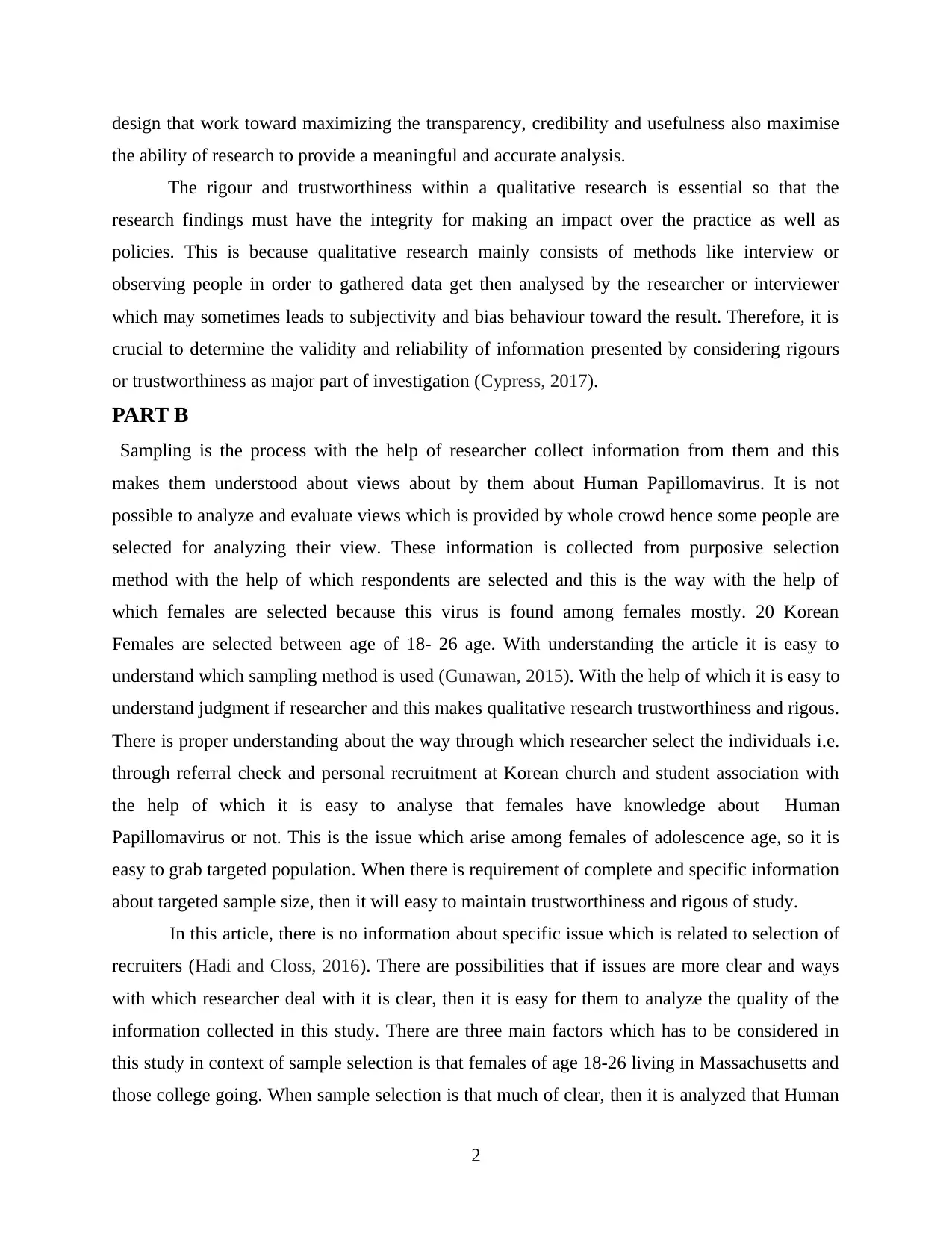
design that work toward maximizing the transparency, credibility and usefulness also maximise
the ability of research to provide a meaningful and accurate analysis.
The rigour and trustworthiness within a qualitative research is essential so that the
research findings must have the integrity for making an impact over the practice as well as
policies. This is because qualitative research mainly consists of methods like interview or
observing people in order to gathered data get then analysed by the researcher or interviewer
which may sometimes leads to subjectivity and bias behaviour toward the result. Therefore, it is
crucial to determine the validity and reliability of information presented by considering rigours
or trustworthiness as major part of investigation (Cypress, 2017).
PART B
Sampling is the process with the help of researcher collect information from them and this
makes them understood about views about by them about Human Papillomavirus. It is not
possible to analyze and evaluate views which is provided by whole crowd hence some people are
selected for analyzing their view. These information is collected from purposive selection
method with the help of which respondents are selected and this is the way with the help of
which females are selected because this virus is found among females mostly. 20 Korean
Females are selected between age of 18- 26 age. With understanding the article it is easy to
understand which sampling method is used (Gunawan, 2015). With the help of which it is easy to
understand judgment if researcher and this makes qualitative research trustworthiness and rigous.
There is proper understanding about the way through which researcher select the individuals i.e.
through referral check and personal recruitment at Korean church and student association with
the help of which it is easy to analyse that females have knowledge about Human
Papillomavirus or not. This is the issue which arise among females of adolescence age, so it is
easy to grab targeted population. When there is requirement of complete and specific information
about targeted sample size, then it will easy to maintain trustworthiness and rigous of study.
In this article, there is no information about specific issue which is related to selection of
recruiters (Hadi and Closs, 2016). There are possibilities that if issues are more clear and ways
with which researcher deal with it is clear, then it is easy for them to analyze the quality of the
information collected in this study. There are three main factors which has to be considered in
this study in context of sample selection is that females of age 18-26 living in Massachusetts and
those college going. When sample selection is that much of clear, then it is analyzed that Human
2
the ability of research to provide a meaningful and accurate analysis.
The rigour and trustworthiness within a qualitative research is essential so that the
research findings must have the integrity for making an impact over the practice as well as
policies. This is because qualitative research mainly consists of methods like interview or
observing people in order to gathered data get then analysed by the researcher or interviewer
which may sometimes leads to subjectivity and bias behaviour toward the result. Therefore, it is
crucial to determine the validity and reliability of information presented by considering rigours
or trustworthiness as major part of investigation (Cypress, 2017).
PART B
Sampling is the process with the help of researcher collect information from them and this
makes them understood about views about by them about Human Papillomavirus. It is not
possible to analyze and evaluate views which is provided by whole crowd hence some people are
selected for analyzing their view. These information is collected from purposive selection
method with the help of which respondents are selected and this is the way with the help of
which females are selected because this virus is found among females mostly. 20 Korean
Females are selected between age of 18- 26 age. With understanding the article it is easy to
understand which sampling method is used (Gunawan, 2015). With the help of which it is easy to
understand judgment if researcher and this makes qualitative research trustworthiness and rigous.
There is proper understanding about the way through which researcher select the individuals i.e.
through referral check and personal recruitment at Korean church and student association with
the help of which it is easy to analyse that females have knowledge about Human
Papillomavirus or not. This is the issue which arise among females of adolescence age, so it is
easy to grab targeted population. When there is requirement of complete and specific information
about targeted sample size, then it will easy to maintain trustworthiness and rigous of study.
In this article, there is no information about specific issue which is related to selection of
recruiters (Hadi and Closs, 2016). There are possibilities that if issues are more clear and ways
with which researcher deal with it is clear, then it is easy for them to analyze the quality of the
information collected in this study. There are three main factors which has to be considered in
this study in context of sample selection is that females of age 18-26 living in Massachusetts and
those college going. When sample selection is that much of clear, then it is analyzed that Human
2
Paraphrase This Document
Need a fresh take? Get an instant paraphrase of this document with our AI Paraphraser
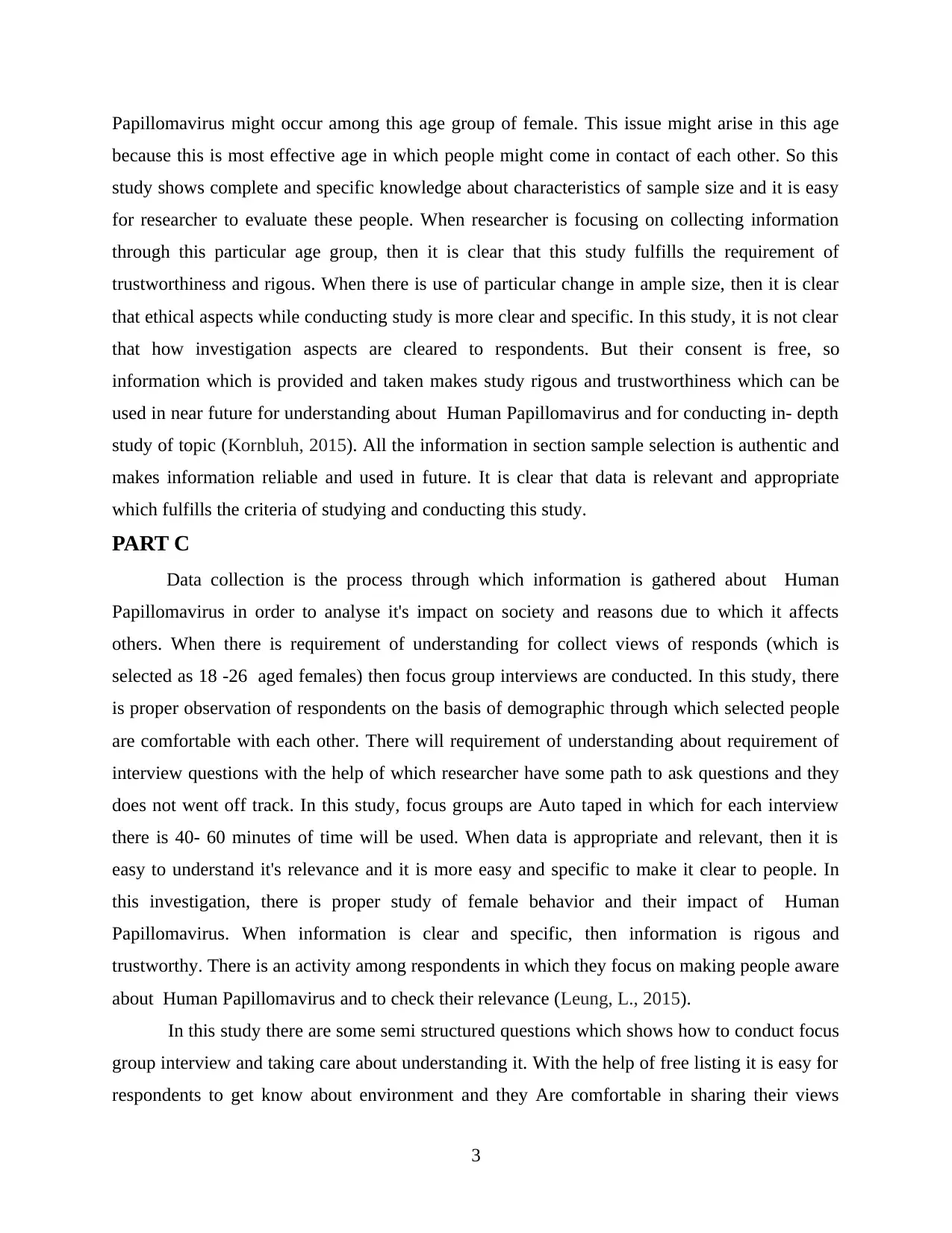
Papillomavirus might occur among this age group of female. This issue might arise in this age
because this is most effective age in which people might come in contact of each other. So this
study shows complete and specific knowledge about characteristics of sample size and it is easy
for researcher to evaluate these people. When researcher is focusing on collecting information
through this particular age group, then it is clear that this study fulfills the requirement of
trustworthiness and rigous. When there is use of particular change in ample size, then it is clear
that ethical aspects while conducting study is more clear and specific. In this study, it is not clear
that how investigation aspects are cleared to respondents. But their consent is free, so
information which is provided and taken makes study rigous and trustworthiness which can be
used in near future for understanding about Human Papillomavirus and for conducting in- depth
study of topic (Kornbluh, 2015). All the information in section sample selection is authentic and
makes information reliable and used in future. It is clear that data is relevant and appropriate
which fulfills the criteria of studying and conducting this study.
PART C
Data collection is the process through which information is gathered about Human
Papillomavirus in order to analyse it's impact on society and reasons due to which it affects
others. When there is requirement of understanding for collect views of responds (which is
selected as 18 -26 aged females) then focus group interviews are conducted. In this study, there
is proper observation of respondents on the basis of demographic through which selected people
are comfortable with each other. There will requirement of understanding about requirement of
interview questions with the help of which researcher have some path to ask questions and they
does not went off track. In this study, focus groups are Auto taped in which for each interview
there is 40- 60 minutes of time will be used. When data is appropriate and relevant, then it is
easy to understand it's relevance and it is more easy and specific to make it clear to people. In
this investigation, there is proper study of female behavior and their impact of Human
Papillomavirus. When information is clear and specific, then information is rigous and
trustworthy. There is an activity among respondents in which they focus on making people aware
about Human Papillomavirus and to check their relevance (Leung, L., 2015).
In this study there are some semi structured questions which shows how to conduct focus
group interview and taking care about understanding it. With the help of free listing it is easy for
respondents to get know about environment and they Are comfortable in sharing their views
3
because this is most effective age in which people might come in contact of each other. So this
study shows complete and specific knowledge about characteristics of sample size and it is easy
for researcher to evaluate these people. When researcher is focusing on collecting information
through this particular age group, then it is clear that this study fulfills the requirement of
trustworthiness and rigous. When there is use of particular change in ample size, then it is clear
that ethical aspects while conducting study is more clear and specific. In this study, it is not clear
that how investigation aspects are cleared to respondents. But their consent is free, so
information which is provided and taken makes study rigous and trustworthiness which can be
used in near future for understanding about Human Papillomavirus and for conducting in- depth
study of topic (Kornbluh, 2015). All the information in section sample selection is authentic and
makes information reliable and used in future. It is clear that data is relevant and appropriate
which fulfills the criteria of studying and conducting this study.
PART C
Data collection is the process through which information is gathered about Human
Papillomavirus in order to analyse it's impact on society and reasons due to which it affects
others. When there is requirement of understanding for collect views of responds (which is
selected as 18 -26 aged females) then focus group interviews are conducted. In this study, there
is proper observation of respondents on the basis of demographic through which selected people
are comfortable with each other. There will requirement of understanding about requirement of
interview questions with the help of which researcher have some path to ask questions and they
does not went off track. In this study, focus groups are Auto taped in which for each interview
there is 40- 60 minutes of time will be used. When data is appropriate and relevant, then it is
easy to understand it's relevance and it is more easy and specific to make it clear to people. In
this investigation, there is proper study of female behavior and their impact of Human
Papillomavirus. When information is clear and specific, then information is rigous and
trustworthy. There is an activity among respondents in which they focus on making people aware
about Human Papillomavirus and to check their relevance (Leung, L., 2015).
In this study there are some semi structured questions which shows how to conduct focus
group interview and taking care about understanding it. With the help of free listing it is easy for
respondents to get know about environment and they Are comfortable in sharing their views
3
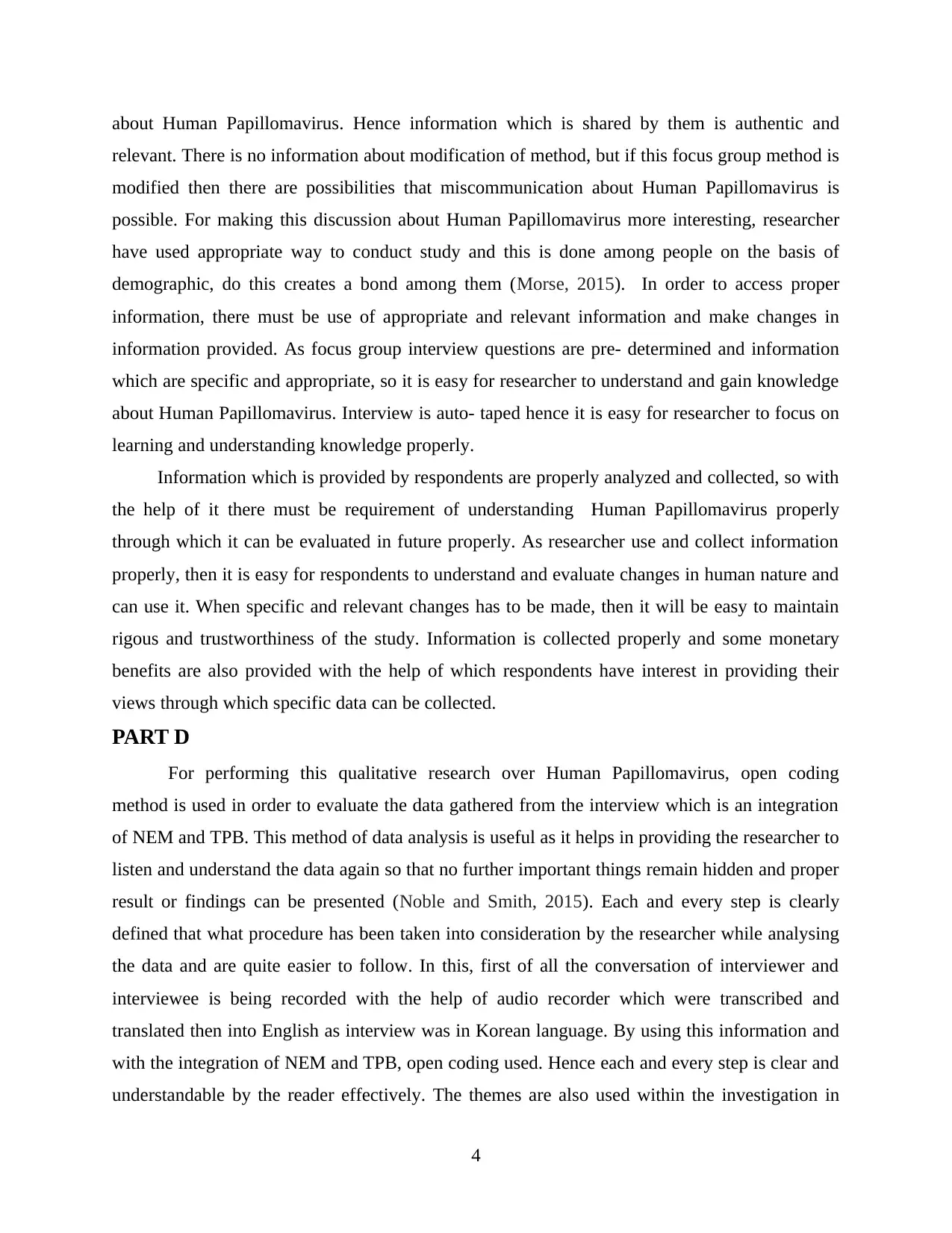
about Human Papillomavirus. Hence information which is shared by them is authentic and
relevant. There is no information about modification of method, but if this focus group method is
modified then there are possibilities that miscommunication about Human Papillomavirus is
possible. For making this discussion about Human Papillomavirus more interesting, researcher
have used appropriate way to conduct study and this is done among people on the basis of
demographic, do this creates a bond among them (Morse, 2015). In order to access proper
information, there must be use of appropriate and relevant information and make changes in
information provided. As focus group interview questions are pre- determined and information
which are specific and appropriate, so it is easy for researcher to understand and gain knowledge
about Human Papillomavirus. Interview is auto- taped hence it is easy for researcher to focus on
learning and understanding knowledge properly.
Information which is provided by respondents are properly analyzed and collected, so with
the help of it there must be requirement of understanding Human Papillomavirus properly
through which it can be evaluated in future properly. As researcher use and collect information
properly, then it is easy for respondents to understand and evaluate changes in human nature and
can use it. When specific and relevant changes has to be made, then it will be easy to maintain
rigous and trustworthiness of the study. Information is collected properly and some monetary
benefits are also provided with the help of which respondents have interest in providing their
views through which specific data can be collected.
PART D
For performing this qualitative research over Human Papillomavirus, open coding
method is used in order to evaluate the data gathered from the interview which is an integration
of NEM and TPB. This method of data analysis is useful as it helps in providing the researcher to
listen and understand the data again so that no further important things remain hidden and proper
result or findings can be presented (Noble and Smith, 2015). Each and every step is clearly
defined that what procedure has been taken into consideration by the researcher while analysing
the data and are quite easier to follow. In this, first of all the conversation of interviewer and
interviewee is being recorded with the help of audio recorder which were transcribed and
translated then into English as interview was in Korean language. By using this information and
with the integration of NEM and TPB, open coding used. Hence each and every step is clear and
understandable by the reader effectively. The themes are also used within the investigation in
4
relevant. There is no information about modification of method, but if this focus group method is
modified then there are possibilities that miscommunication about Human Papillomavirus is
possible. For making this discussion about Human Papillomavirus more interesting, researcher
have used appropriate way to conduct study and this is done among people on the basis of
demographic, do this creates a bond among them (Morse, 2015). In order to access proper
information, there must be use of appropriate and relevant information and make changes in
information provided. As focus group interview questions are pre- determined and information
which are specific and appropriate, so it is easy for researcher to understand and gain knowledge
about Human Papillomavirus. Interview is auto- taped hence it is easy for researcher to focus on
learning and understanding knowledge properly.
Information which is provided by respondents are properly analyzed and collected, so with
the help of it there must be requirement of understanding Human Papillomavirus properly
through which it can be evaluated in future properly. As researcher use and collect information
properly, then it is easy for respondents to understand and evaluate changes in human nature and
can use it. When specific and relevant changes has to be made, then it will be easy to maintain
rigous and trustworthiness of the study. Information is collected properly and some monetary
benefits are also provided with the help of which respondents have interest in providing their
views through which specific data can be collected.
PART D
For performing this qualitative research over Human Papillomavirus, open coding
method is used in order to evaluate the data gathered from the interview which is an integration
of NEM and TPB. This method of data analysis is useful as it helps in providing the researcher to
listen and understand the data again so that no further important things remain hidden and proper
result or findings can be presented (Noble and Smith, 2015). Each and every step is clearly
defined that what procedure has been taken into consideration by the researcher while analysing
the data and are quite easier to follow. In this, first of all the conversation of interviewer and
interviewee is being recorded with the help of audio recorder which were transcribed and
translated then into English as interview was in Korean language. By using this information and
with the integration of NEM and TPB, open coding used. Hence each and every step is clear and
understandable by the reader effectively. The themes are also used within the investigation in
4
⊘ This is a preview!⊘
Do you want full access?
Subscribe today to unlock all pages.

Trusted by 1+ million students worldwide
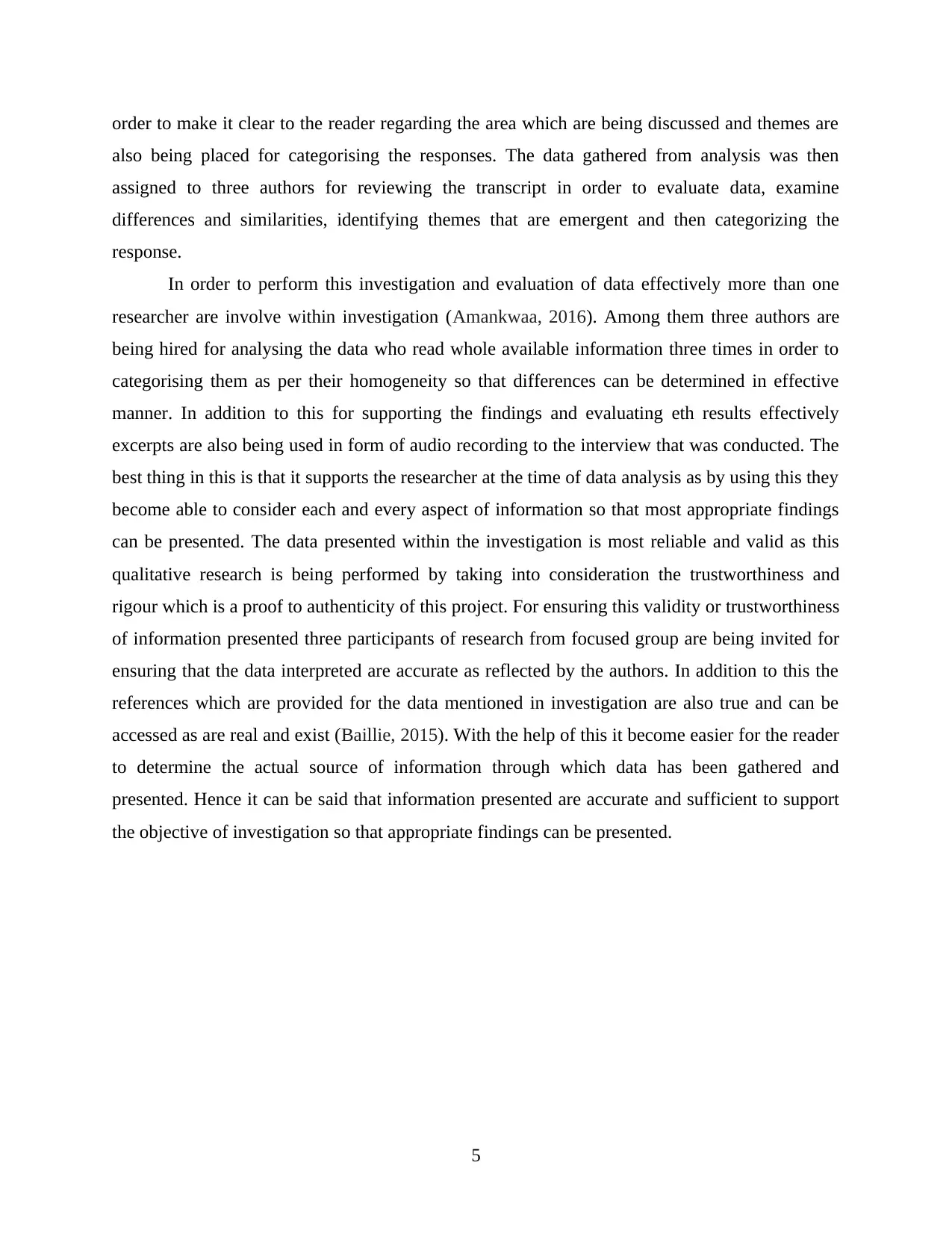
order to make it clear to the reader regarding the area which are being discussed and themes are
also being placed for categorising the responses. The data gathered from analysis was then
assigned to three authors for reviewing the transcript in order to evaluate data, examine
differences and similarities, identifying themes that are emergent and then categorizing the
response.
In order to perform this investigation and evaluation of data effectively more than one
researcher are involve within investigation (Amankwaa, 2016). Among them three authors are
being hired for analysing the data who read whole available information three times in order to
categorising them as per their homogeneity so that differences can be determined in effective
manner. In addition to this for supporting the findings and evaluating eth results effectively
excerpts are also being used in form of audio recording to the interview that was conducted. The
best thing in this is that it supports the researcher at the time of data analysis as by using this they
become able to consider each and every aspect of information so that most appropriate findings
can be presented. The data presented within the investigation is most reliable and valid as this
qualitative research is being performed by taking into consideration the trustworthiness and
rigour which is a proof to authenticity of this project. For ensuring this validity or trustworthiness
of information presented three participants of research from focused group are being invited for
ensuring that the data interpreted are accurate as reflected by the authors. In addition to this the
references which are provided for the data mentioned in investigation are also true and can be
accessed as are real and exist (Baillie, 2015). With the help of this it become easier for the reader
to determine the actual source of information through which data has been gathered and
presented. Hence it can be said that information presented are accurate and sufficient to support
the objective of investigation so that appropriate findings can be presented.
5
also being placed for categorising the responses. The data gathered from analysis was then
assigned to three authors for reviewing the transcript in order to evaluate data, examine
differences and similarities, identifying themes that are emergent and then categorizing the
response.
In order to perform this investigation and evaluation of data effectively more than one
researcher are involve within investigation (Amankwaa, 2016). Among them three authors are
being hired for analysing the data who read whole available information three times in order to
categorising them as per their homogeneity so that differences can be determined in effective
manner. In addition to this for supporting the findings and evaluating eth results effectively
excerpts are also being used in form of audio recording to the interview that was conducted. The
best thing in this is that it supports the researcher at the time of data analysis as by using this they
become able to consider each and every aspect of information so that most appropriate findings
can be presented. The data presented within the investigation is most reliable and valid as this
qualitative research is being performed by taking into consideration the trustworthiness and
rigour which is a proof to authenticity of this project. For ensuring this validity or trustworthiness
of information presented three participants of research from focused group are being invited for
ensuring that the data interpreted are accurate as reflected by the authors. In addition to this the
references which are provided for the data mentioned in investigation are also true and can be
accessed as are real and exist (Baillie, 2015). With the help of this it become easier for the reader
to determine the actual source of information through which data has been gathered and
presented. Hence it can be said that information presented are accurate and sufficient to support
the objective of investigation so that appropriate findings can be presented.
5
Paraphrase This Document
Need a fresh take? Get an instant paraphrase of this document with our AI Paraphraser
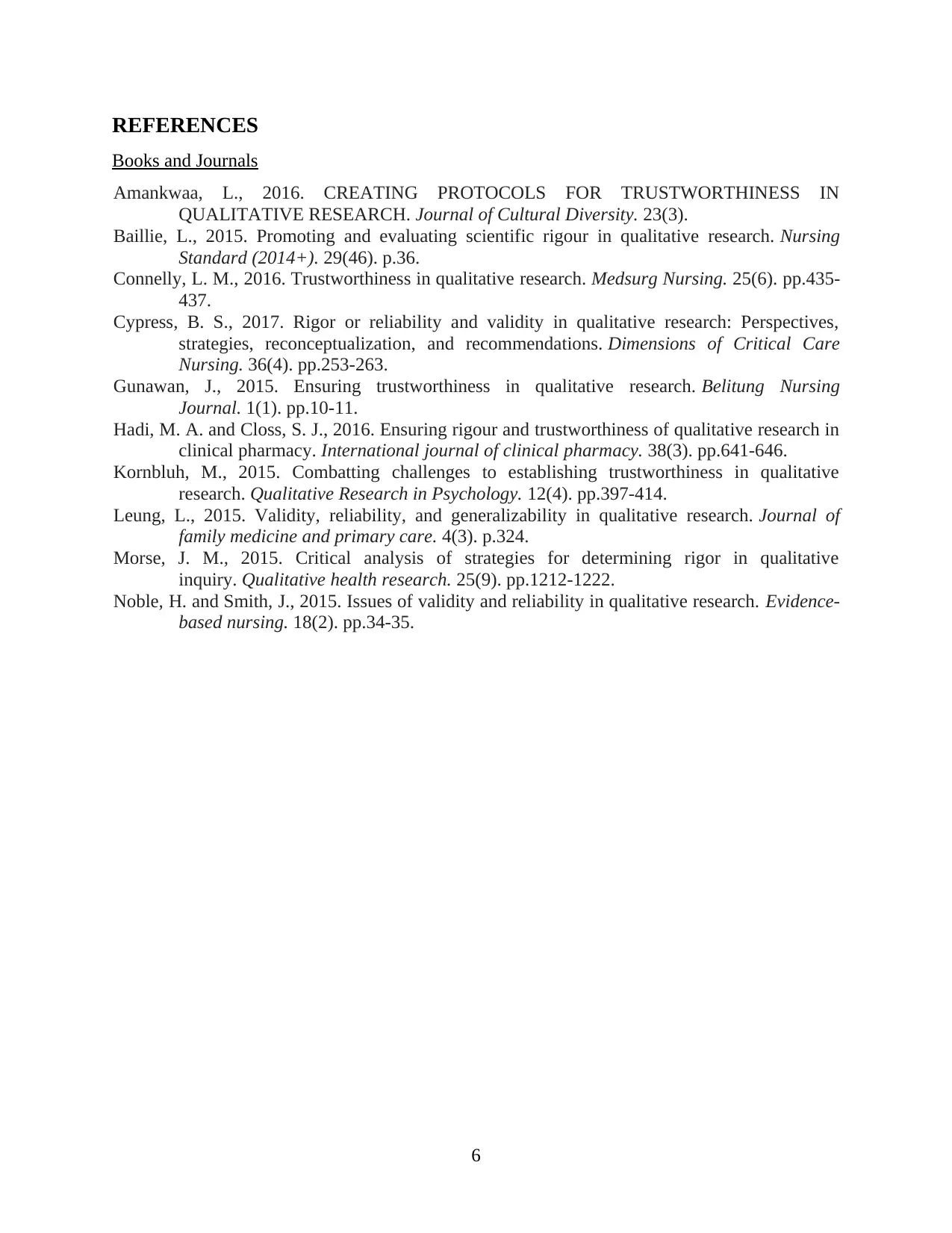
REFERENCES
Books and Journals
Amankwaa, L., 2016. CREATING PROTOCOLS FOR TRUSTWORTHINESS IN
QUALITATIVE RESEARCH. Journal of Cultural Diversity. 23(3).
Baillie, L., 2015. Promoting and evaluating scientific rigour in qualitative research. Nursing
Standard (2014+). 29(46). p.36.
Connelly, L. M., 2016. Trustworthiness in qualitative research. Medsurg Nursing. 25(6). pp.435-
437.
Cypress, B. S., 2017. Rigor or reliability and validity in qualitative research: Perspectives,
strategies, reconceptualization, and recommendations. Dimensions of Critical Care
Nursing. 36(4). pp.253-263.
Gunawan, J., 2015. Ensuring trustworthiness in qualitative research. Belitung Nursing
Journal. 1(1). pp.10-11.
Hadi, M. A. and Closs, S. J., 2016. Ensuring rigour and trustworthiness of qualitative research in
clinical pharmacy. International journal of clinical pharmacy. 38(3). pp.641-646.
Kornbluh, M., 2015. Combatting challenges to establishing trustworthiness in qualitative
research. Qualitative Research in Psychology. 12(4). pp.397-414.
Leung, L., 2015. Validity, reliability, and generalizability in qualitative research. Journal of
family medicine and primary care. 4(3). p.324.
Morse, J. M., 2015. Critical analysis of strategies for determining rigor in qualitative
inquiry. Qualitative health research. 25(9). pp.1212-1222.
Noble, H. and Smith, J., 2015. Issues of validity and reliability in qualitative research. Evidence-
based nursing. 18(2). pp.34-35.
6
Books and Journals
Amankwaa, L., 2016. CREATING PROTOCOLS FOR TRUSTWORTHINESS IN
QUALITATIVE RESEARCH. Journal of Cultural Diversity. 23(3).
Baillie, L., 2015. Promoting and evaluating scientific rigour in qualitative research. Nursing
Standard (2014+). 29(46). p.36.
Connelly, L. M., 2016. Trustworthiness in qualitative research. Medsurg Nursing. 25(6). pp.435-
437.
Cypress, B. S., 2017. Rigor or reliability and validity in qualitative research: Perspectives,
strategies, reconceptualization, and recommendations. Dimensions of Critical Care
Nursing. 36(4). pp.253-263.
Gunawan, J., 2015. Ensuring trustworthiness in qualitative research. Belitung Nursing
Journal. 1(1). pp.10-11.
Hadi, M. A. and Closs, S. J., 2016. Ensuring rigour and trustworthiness of qualitative research in
clinical pharmacy. International journal of clinical pharmacy. 38(3). pp.641-646.
Kornbluh, M., 2015. Combatting challenges to establishing trustworthiness in qualitative
research. Qualitative Research in Psychology. 12(4). pp.397-414.
Leung, L., 2015. Validity, reliability, and generalizability in qualitative research. Journal of
family medicine and primary care. 4(3). p.324.
Morse, J. M., 2015. Critical analysis of strategies for determining rigor in qualitative
inquiry. Qualitative health research. 25(9). pp.1212-1222.
Noble, H. and Smith, J., 2015. Issues of validity and reliability in qualitative research. Evidence-
based nursing. 18(2). pp.34-35.
6
1 out of 8
Related Documents
Your All-in-One AI-Powered Toolkit for Academic Success.
+13062052269
info@desklib.com
Available 24*7 on WhatsApp / Email
![[object Object]](/_next/static/media/star-bottom.7253800d.svg)
Unlock your academic potential
Copyright © 2020–2025 A2Z Services. All Rights Reserved. Developed and managed by ZUCOL.




